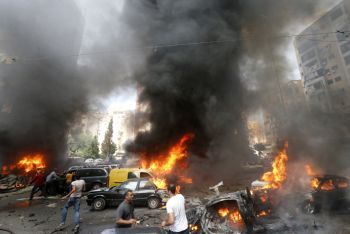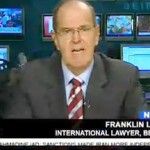
Publisher:
Bonnie King
CONTACT:
Newsroom@Salem-news.com
Advertising:
Adsales@Salem-news.com

~Truth~
~Justice~
~Peace~
TJP
Aug-17-2013 02:29

 TweetFollow @OregonNews
TweetFollow @OregonNews
Targeting Hezbollah in Beirut
Dr. Franklin Lamb Salem-News.comIsrael and Al Qaeda Top Suspects List in Second Bombing Attack in Five Weeks
 Residents at the site of an explosion in Beirut's southern suburb neighbourhood of Bir al-Abed on July 9, 2013 (AFP Photo / Str) |
(Makfouz Rouweiss store, Dahiyeh) - This observer was sitting with my friend Zuhair on my balcony in south Beirut, when at 6:20 pm on 8/15/13 erupted a huge blast that seemed to shake our 12 story concrete building even more so than the one just down the street did on July 9. We both leaned over the railing at the same time. I commented that I did not see any smoke, while he spoke only two words: “Bir Abed.”
He meant, as it turned out, that rather than two blocks east and one north of our building’s entrance, as was the case with the last blast, this one was three blocks east and three south. Though on the same road as the July bombing, today’s attack was about two hundred yards from the Hezbollah Media Relations office, run by my friend Dr. Ibrahim Mousawi, located at the end of our street.
Zuhair and I parted without speaking, and thanks to my motorbike being known to many of the security guys, who within minutes of the blast were moving traffic barriers into place, I arrived at the scene in short order. Screams, wails, shouting, and the smell of scorched bodies filled the evening air, as massive flames from burning cars and destroyed shop fronts swept skyward. A dense, black smoke plumed over the area, visible for miles.
For more than an hour I stood, just inside a women’s shoe store whose front had been blown off though sometimes venturing a few steps in either direction along the sidewalk, watching, grimacing, yet also wanting to stay out of the way, as emergency vehicles arrived. At the same time thousands, not hundreds, of Hezbollah security and supporters appeared out of nowhere, many of them armed, beginning to direct fire trucks and ambulances, lending assistance to wounded neighbors. Shouting and emotions could be heard in all directions—grown men crying, women praying—though before long my attention was drawn to a group of young men beating their chests in defiance, chanting “Haidar, Haidar, Haidar.” It is the Shia ritual meant to identify with the events of Karba in the year 680, when Hussein bin Ali, son in law of the Prophet Mohammad (pbuh) sacrificed himself in defense of Islam.
A particularly bizarre incident, for this observer, occurred when a friend called and asked where I was and if I was ok. I replied, “I am at the scene near Mahfouz Stores in Ruwais, next to a butcher shop and down the block from Banque Libano-Française and Harkous Chicken Restaurant.” She later told me those were my exact words.
When we hung up the phone, I glanced again to my right and did a double take—at what appeared to be a sheep carcass, partly carved by a butcher, or maybe half a hanging cow. Both are a common sight in this part of the world. Moments passed; I glanced again at the suspended slab, no more than five feet away, thinking to myself that the explosive device must have contained pellets, for the animal’s flesh, which had visibly darkened in color since I had arrived half an hour earlier, seemed riddled and partly shredded. Surrounded by chaos and disembarking EMS vehicles, I didn’t pay much attention to it, though not much later a Hezbollah security/civil defense worker came and stood next to me. I had seen him around the neighborhood before, and though I always keep an ID at ready, he did not ask me for one.
“Animal! Dog!” he exclaimed in disgust as he glared at the dangling carcass and spit.
“Aiwa, maybe a sheep or cow, but surely not a dog,” this observer replied obtusely.
He looked at me quizzically and proffered, “You no understand. This is the dog who did the operation!”
In other words, it was not a sheep but the suicide bomber I had been standing next to.
The man appears to have been the driver of a white van that neighbors say they saw driving back and forth looking for a parking space just before the blast. Glancing anew at the hanging carcass, I saw what did look like part of a leg, and perchance half an arm, but the mass of its flesh was in the middle and included what resembled a stomach and organs.
At this point it dawned on me—ever so slowly, as many things do these days—we were not even in front of a butcher shop! Instead, we stood next to a shop selling pink and gold handbags, strewn now over the sidewalk, located next to the shoe store. And there was no butcher’s hook to be seen. Rather, the body had been blown across the intersection and lodged between two thick workmen’s planks, perhaps 12 feet off the ground, on rusty, thick, metal scaffolding.
I could not see if there was a head attached, and did not want to appear nosy, but something was keeping the body hanging just above us, between the two planks. Soon three other guys arrived and, presumably out of Islamic respect for the dead, two of them climbed the scaffolding, at which point they tore some plastic strips off a banner advertising a sale, draping it over the remains. I am not sure how the security guys were so certain it was the remains of the bomber rather than one of the so-far 27 presumed killed, but somehow they were.
Additionally, as of press time, more than 340 are reported wounded, while a father and three of his children remain unaccounted for. The victims were rushed to Hezbollah’s Rassoul Hospital, on Airport Road, and to Bahman Hospital, next to where I live, run by the Sayed Mohamad Hussein Fadallah charity; still others were taken to Al Bourj and Sahel hospitals in our neighborhood. The explosion also has left some 350 families displaced.
Almost predictably, some local politicians are blaming Israel, whose government has denied any involvement. Druze leader Walid Jumblatt and Parliament Speaker Nabih Berri both are accusing Israel, in almost knee-jerk fashion. President Suleiman said the Dahiyeh blast “bears the hallmark of terrorism and Israel,” adding that “all Lebanese must show solidarity." Their accusations are probably based not on hard evidence but an admirable attempt to tamp down Sunni-Shia speculations and suspicions.
However, analyst and Hezbollah expert Waddah Charara, whose views this observer particularly values, said Hezbollah’s arch-enemy Israel could have been behind this latest car-bombing. “I think the attack is part of a war being waged between Israel and the Shiite movement—that recently brought on the Israeli soldiers’ incursion into Lebanese territory,” he told the media.
Hezbollah had not taken a clear position as of press time, but SG Hassan Nasrallah is scheduled to speak tonight and give this thoughts.
Fadallah MP, Dr. Ali Fayed, whom I consider a valued friend and who is one of those within Hezbollah working to enact the elementary right to work and to own a home for Palestinian refugees in Lebanon, appeared last night on NBN TV. Fayed called the bombing a “very dangerous act,” but highlighted that Hezbollah and its supporters will not be dragged into strife. He also said that regardless of who did the bombing, and whether or not “it’s Israel or terrorist organizations” behind the attack, the Lebanese must unite.
There are plenty of other suspects—both here in Lebanon, as well as amongst militant groups inside Syria, who have moved elements into Beirut. A video, uploaded hours after the blast, shows residents of the rebel-held city of Raqqa, the only provincial capital in Syria outside regime control, celebrating the devastating car-bomb attack while offering sweets to passers-by and holding a banner reading: “Distributing sweets on the occasion of the explosion in Beirut’s Dahiyeh.”
One of the more than two hundred active militias in Syria, which calls itself the Company of Aisha Umm al-Muminin (named for the Prophet Mohammed’s favorite wife) is additionally claiming responsibility, while several other Syrian rebel groups, some with members now in Lebanon, have issued threats against Hezbollah and vowed to target it.
Analysis of the increased number of security cameras in our neighborhood may reveal more clues, plus it is rumored that one suspect was arrested at the scene and is being interrogated. Revisiting the area this morning at 3 a.m., this observer found it cordoned off, floodlit, and with numerous investigators working the scene.
Meanwhile, caretaker Prime Minister Najib Miqati has called for a national day of mourning on 8/16/13.
 Franklin Lamb is doing research in Syria and can be reached c/o fplamb@gmail.com
Franklin Lamb is doing research in Syria and can be reached c/o fplamb@gmail.com
He is the author of The Price We Pay: A Quarter-Century of Israel’s Use of American Weapons Against Civilians in Lebanon. He contribute to Uprooted Palestinians Blog
Please Sign
http://www.petitiononline.com/
Beirut Mobile: +961-70-497-804
 Dr. Franklin Lamb is Director of the Sabra Shatila Foundation. Contact him at: fplamb@sabrashatila.org. He is working with the Palestine Civil Rights Campaign in Lebanon on drafting legislation which, after 62 years, would, if adopted by Lebanon’s Cabinet and Parliament grant the right to work and to own a home to Lebanon’s Palestinian Refugees. One part of the PCRC legislative project is its online Petition which can be viewed and signed at: petitiononline.com/ssfpcrc/petition.html. Lamb is reachable at fplamb@palestinecivilrightscampaign.org.
Franklin Lamb’s book on the Sabra-Shatila Massacre, International Legal Responsibility for the Sabra-Shatila Massacre, now out of print, was published in 1983, following Janet’s death and was dedicated to Janet Lee Stevens. He was a witness before the Israeli Kahan Commission Inquiry, held at Hebrew University in Jerusalem in January 1983.
Dr. Franklin Lamb is Director of the Sabra Shatila Foundation. Contact him at: fplamb@sabrashatila.org. He is working with the Palestine Civil Rights Campaign in Lebanon on drafting legislation which, after 62 years, would, if adopted by Lebanon’s Cabinet and Parliament grant the right to work and to own a home to Lebanon’s Palestinian Refugees. One part of the PCRC legislative project is its online Petition which can be viewed and signed at: petitiononline.com/ssfpcrc/petition.html. Lamb is reachable at fplamb@palestinecivilrightscampaign.org.
Franklin Lamb’s book on the Sabra-Shatila Massacre, International Legal Responsibility for the Sabra-Shatila Massacre, now out of print, was published in 1983, following Janet’s death and was dedicated to Janet Lee Stevens. He was a witness before the Israeli Kahan Commission Inquiry, held at Hebrew University in Jerusalem in January 1983.
 |
 |
 |
Articles for August 16, 2013 | Articles for August 17, 2013 | Articles for August 18, 2013
Quick Links
DINING
Willamette UniversityGoudy Commons Cafe
Dine on the Queen
Willamette Queen Sternwheeler
MUST SEE SALEM
Oregon Capitol ToursCapitol History Gateway
Willamette River Ride
Willamette Queen Sternwheeler
Historic Home Tours:
Deepwood Museum
The Bush House
Gaiety Hollow Garden
AUCTIONS - APPRAISALS
Auction Masters & AppraisalsCONSTRUCTION SERVICES
Roofing and ContractingSheridan, Ore.
ONLINE SHOPPING
Special Occasion DressesAdvertise with Salem-News
Contact:AdSales@Salem-News.com

googlec507860f6901db00.html



Terms of Service | Privacy Policy
All comments and messages are approved by people and self promotional links or unacceptable comments are denied.
[Return to Top]
©2025 Salem-News.com. All opinions expressed in this article are those of the author and do not necessarily reflect those of Salem-News.com.